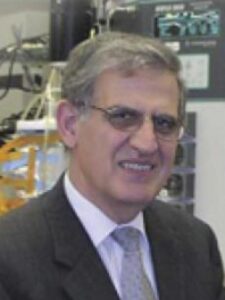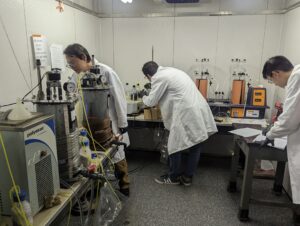In a world where the most profound discoveries often bubble up from the most unexpected places, City College’s Dr. John Fillos, leading a cohort of students in studying the New York City Department of Environmental Protection’s local wastewater treatment facilities, is flushing away preconceived notions about where groundbreaking research can occur.

Dr. John Fillos. Photo: CCNY
Over the past three decades, Dr. John Fillos’s partnership with the NYCDEP has been a catalyst for academic growth and professional development for numerous students at City College. Fillos reflects on the fruitful journey, emphasizing the breadth of engagement from the student body, which spans from undergraduate to doctoral levels, not only facilitating hands-on research in wastewater treatment but also providing paid positions.
This blend of practical work and academic research has culminated in several students completing their doctoral studies, an experience proving beneficial, nurturing a generation of scholars and practitioners in the field of environmental science.
“It has been very rewarding for all of us… in terms of the work that we have done and the number of students we were able to help — most of them weren’t just working in the lab, they were also getting paid,” Fillos told The RICC.
In particular, the research involves one key element: nitrogen removal.
Since Fillos began working with the city optimizing wastewater treatment plants about 30 years ago, a lot has changed in New York City’s waterways. The city now treats roughly 1.3 billion gallons of wastewater at 14 different plants daily. Every five years, the city ensures the treated water discharged into the East and Hudson River or Jamaica Bay complies with certain mandatory maximums — one of which is its nitrogen content.
In the early 1990s, the Northeast had a serious problem. The American lobster fishing industry, once a thriving enterprise, was decimated — all throughout the Long Island Sound and along the coast of Connecticut, lobsters were dying.
After researchers from Connecticut, New York State, and the U.S. Environmental Protection Agency investigated further, they found that oxygen levels had dropped dramatically. The excessive discharge of phosphorus and nitrogen into the water led to the rapid growth of algae. As the algae decayed, it settled into the sediment and attracted bacteria and other decomposers, which resulted in a drastic reduction of dissolved oxygen in the water due to the breakdown process.
“So, the city had to do its part and remove the nitrogen, and we were involved in, basically, ‘How do you adjust the process within the existing footprint to be able to remove nitrogen from the wastewater?’” Fillos said.
Since the city first began regulating the maximum amounts of nitrogen allowed in wastewater effluent in the 1990s, the requirement has been reduced to 44,325 pounds of nitrogen per day, roughly equating to approximately 15.5 milligrams of nitrogen per gallon of wastewater.
The process of nitrogen removal primarily involves biological processes known as nitrification and denitrification. During the first stage, called nitrification, aerobic bacteria convert ammonia present in the wastewater to nitrite and then to nitrate. During the denitrification stage, different sets of anaerobic bacteria convert these nitrates into nitrogen gas, which is then released into the atmosphere, thereby removing nitrogen from the wastewater.
“Because all this water is discharged into the surrounding bodies, they have to get a permit from the state of New York,” Fillos explained. “They’ve gotten very specific in terms of what they’re looking for. So, the whole idea for the city to comply with these discharge permits, they have to upgrade the facility, because these permits are dynamic and are reviewed every five years. Because things are changing — the needs change. The technology has to be adapted to satisfy the permits.”
His team primarily works in the field at each of these plants, sometimes doing pilot studies but often working on full-scale experiments to explore the most efficient and cost-effective options offered by differing species of bacteria at different stages.

Courtesy of Krish Ramalingam
Through the years, Fillos has witnessed firsthand a transition in the government’s perspective toward water treatment, one that can be best exemplified by the various name changes the plants he researches have undergone.
“If you go back to, say, 30 or 40 years ago, these plants were called ‘water pollution control plants,’” Fillos said. “And that’s exactly what it was — water pollution control — they wanted to control the pollution that goes into the river. But then it evolved into ‘wastewater treatment facilities,’ the wastewater is coming in and you treat the wastewater and then you send it out so it meets the water quality requirements of the river or the water body that is receiving it. Then, over the last 10 years, ‘wastewater treatment plant’ has now morphed into ‘wastewater resource recovery facilities’ because we realized that there is a lot of energy in this water.”
The change, from water pollution control to water resource recovery, shows the city has looked to scientists like Fillos to renew vital water assets. Once the treated water becomes reusable, it offers numerous advantages. Fillos noted that some countries, like Singapore, invested enough in the treatment processes’ “last mile” to produce drinkable water.

Krish Ramalingam. Photo: CCNY
“The bottom line here is we are looking at decarbonization, we are looking at getting energy out of it, we are looking at net neutral plants or net positive plants,” Krish Ramalingam, director of research and project manager for the Applied Research Program at the NYC DEP, told The RICC. “The whole emphasis now is on energy, decarbonization, process intensification, and resiliency, all of those — because of climate change… Things are dynamic — they keep changing. So, you have to adapt yourself to all of these changes.”
Judah is a senior at CUNY Baruch College, pursuing a major in journalism and minors in computer science and environmental sustainability. He is also the business editor for Baruch’s independent student newspaper, The Ticker, and co-managing editor for the Baruch Journalism Department’s magazine Dollars & Sense.